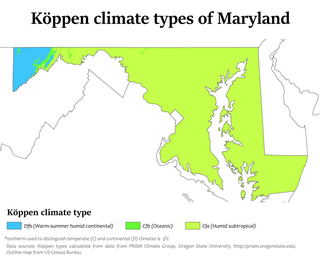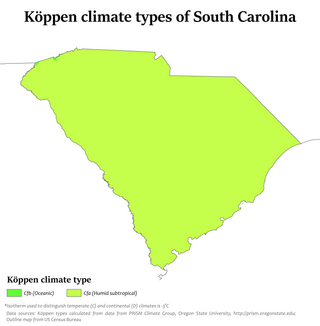
Climate change in the US state of Washington is a subject of study and projection today. The major impacts of climate change in Washington State include increase in carbon dioxide levels, increase in temperatures, earlier annual snow melt, sea level rise, and others.

The effects of climate change on small island countries are affecting people in coastal areas through sea level rise, increasing heavy rain events, tropical cyclones and storm surges. These effects of climate change threaten the existence of many island countries, their peoples and cultures. They also alter ecosystems and natural environments in those countries. Small island developing states (SIDS) are a heterogenous group of countries but many of them are particularly at risk to climate change. Those countries have been quite vocal in calling attention to the challenges they face from climate change. For example, the Maldives and nations of the Caribbean and Pacific Islands are already experiencing considerable impacts of climate change. It is critical for them to implement climate change adaptation measures fast.

Climate change in Connecticut encompasses the effects of climate change, attributed to man-made increases in atmospheric carbon dioxide, in the U.S. state of Connecticut.

Climate change in Delaware encompasses the effects of climate change, attributed to man-made increases in atmospheric carbon dioxide, in the U.S. state of Delaware.
Climate change in Guam encompasses the effects of climate change, attributed to man-made increases in atmospheric carbon dioxide, in the U.S. territory of Guam.

Climate change in Illinois encompasses the effects of climate change, attributed to man-made increases in atmospheric carbon dioxide, in the U.S. state of Illinois.

Climate change in Louisiana encompasses the effects of climate change, attributed to man-made increases in atmospheric carbon dioxide, in the U.S. state of Louisiana.

Climate change in Maine encompasses the effects of climate change, attributed to man-made increases in atmospheric carbon dioxide, methane, and nitrous oxides, in the U.S. state of Maine. The United States Environmental Protection Agency reports that Maine has warmed roughly three degrees F since 1900. Sea level in Maine has risen eight inches since the 1950s.

Climate change in Maryland encompasses the effects of climate change, attributed to man-made increases in atmospheric carbon dioxide, in the U.S. state of Maryland.

Climate change in Mississippi encompasses the effects of climate change, attributed to man-made increases in atmospheric carbon dioxide, in the U.S. state of Mississippi.

Climate change in New Hampshire encompasses the effects of climate change, attributed to man-made increases in atmospheric carbon dioxide, in the U.S. state of New Hampshire.

Climate change has had large impacts on the ecosystems and landscapes of the US territory Puerto Rico. According to a 2019 report by Germanwatch, Puerto Rico is the most affected by climate change. The territory's energy consumption is mainly derived from imported fossil fuels.

Climate change in Rhode Island encompasses the effects of climate change, attributed to man-made increases in atmospheric carbon dioxide, in the U.S. state of Rhode Island.

Climate change in South Carolina encompasses the effects of climate change, attributed to man-made increases in atmospheric carbon dioxide, in the U.S. state of South Carolina.

Climate change in Virginia encompasses the effects of climate change, attributed to man-made increases in atmospheric carbon dioxide, in the U.S. state of Virginia.

Climate changein the Caribbean poses major risks to the islands in the Caribbean. The main environmental changes expected to affect the Caribbean are a rise in sea level, stronger hurricanes, longer dry seasons and shorter wet seasons. As a result, climate change is expected to lead to changes in the economy, environment and population of the Caribbean. Temperature rise of 2°C above preindustrial levels can increase the likelihood of extreme hurricane rainfall by four to five times in the Bahamas and three times in Cuba and the Dominican Republic. A rise in sea level could impact coastal communities of the Caribbean if they are less than 3 metres (10 ft) above the sea. In Latin America and the Caribbean, it is expected that 29–32 million people may be affected by the sea level rise because they live below this threshold. The Bahamas is expected to be the most affected because at least 80% of the total land is below 10 meters elevation.

Climate change in North Carolina is of concern due to its impacts on the environment, climate, people, and economy of North Carolina. "Most of the state has warmed one-half to one degree (F) in the last century, and the sea is rising about one inch every decade." North Carolina, along with the rest of the Southeastern United States, has warmed less than the rest of the country.

Climate change in New York encompasses the effects of climate change, attributed to man-made increases in atmospheric greenhouse gases, in the U.S. state of New York. It is of concern due to its impact on the people, ecosystem, and economy of the state. Many parts of the state are already experiencing weather changes, and sea-level rise, and threatening local communities.
Climate change may have a range of impacts in the Republic of Ireland. Increasing temperatures may change weather patterns, with the potential for increased heatwaves, rainfall and storm events, with subsequent impacts on people through flooding Climate change has been assessed to be the single biggest threat to Ireland, according to the head of the Defence Forces of Ireland, Mark Mellett.

Climate change in Pennsylvania encompasses the effects of climate change, attributed to man-made increases in atmospheric carbon dioxide, in the U.S. state of Pennsylvania.




























